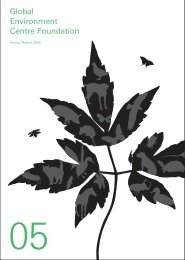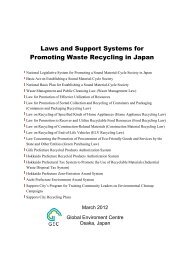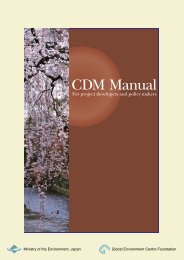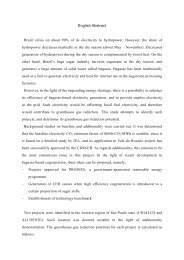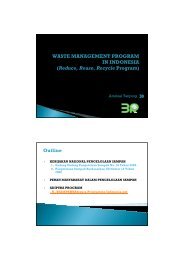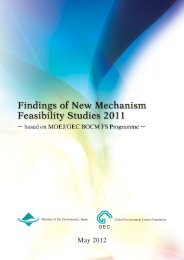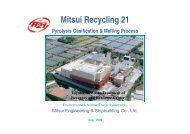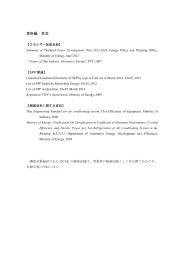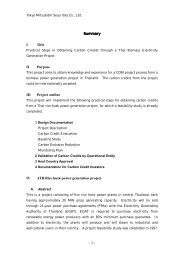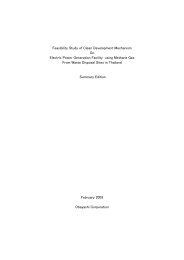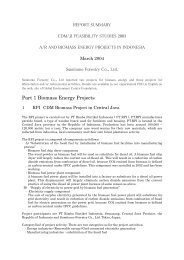PDF File - GEC
PDF File - GEC
PDF File - GEC
Create successful ePaper yourself
Turn your PDF publications into a flip-book with our unique Google optimized e-Paper software.
Methodologies using this tool are only applicable if all potential alternative scenarios to the proposed<br />
project activity are available options to project participants. For example, it applies to project<br />
activities that make modifications to an existing installation that is operated by project participants.<br />
Moreover, this applies to the construction of new facilities if all alternative scenarios to the project<br />
activity are available options to project participants, i.e. if all alternative scenarios could be<br />
implemented by the project participants. For example, it may be applied to a cement manufacturer<br />
that plans to construct a new cement plant and has access to all cement production technologies. The<br />
EB revised the combined tool to expand its applicability to newly built facilities where the alternative<br />
scenarios to the project activity are available options to project participants [EB28, Annex 14].<br />
However, methodologies using this tool are not applicable to project activities where one or<br />
more alternative scenarios to the proposed project activity are not available options to the<br />
project participant. In these cases, a different procedure than provided here would be required to<br />
demonstrate additionality and identify the baseline scenario.<br />
The Meth Panel is considering whether to expanding this tool to cover all cases that would be<br />
appropriate. In the meantime, methodologies that typically involve alternatives are not under<br />
the control of project participants can continue to use, if desired, the additionality tool (provides<br />
benchmark and other tools), and provide their own methods to develop and/or assess baseline<br />
scenario.<br />
Since the methodological procedure to identify the baseline scenario and demonstrate additionality<br />
by the combined tool and by the additionality tool is the same, the step-wise approach is discussed<br />
in Appendix 5.<br />
3.2.5 Additionality [PDD section B.5]<br />
Project participants should follow the prescription of the baseline methodology to be applied to the<br />
project activity, in order to demonstrate additionality of the project activity. Project participants are<br />
asked to explain and justify key assumptions and rationales used in demonstrating additionality, as<br />
well as to provide relevant documentation of references. If the starting date of the project activity is<br />
before the date of validation, project participants are asked to provide evidence that the incentive<br />
from the CDM was seriously considered in the decision to proceed with the project activity. This<br />
evidence shall be based on (preferably official, legal and/or other corporate) documentation that was<br />
available at, or prior to, the start of the project activity. AMs often require the use of the additionality<br />
tool 8 [EB39, Annex 10]. The additionality tool provides for a step-wise approach to demonstrate and<br />
assess additionality (see Appendix 5).<br />
3.2.6 Calculating emission reductions [PDD section B.6]<br />
Baseline methodologies specify how emission reductions must be calculated in the PDD. In section<br />
B.6.1. “Explanation of methodological choices”, project participants are required to state which<br />
equations will be used in calculating emission reductions, as well as to explain and justify their<br />
choices made among different options presented in the baseline methodology applied to the project<br />
activity.<br />
8 http://cdm.unfccc.int/methodologies/PAmethodologies/AdditionalityTools/Additionality_tool.pdf<br />
47



